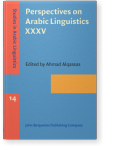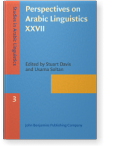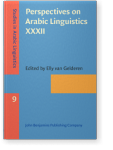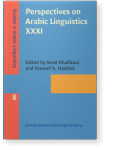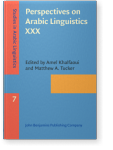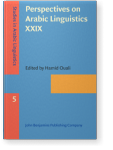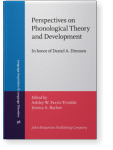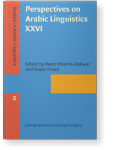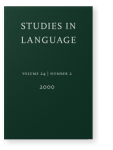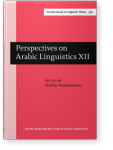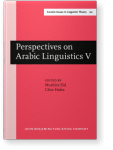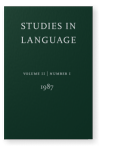Stuart Davis
List of John Benjamins publications for which Stuart Davis plays a role.
Book series
Title
Perspectives on Arabic Linguistics XXVII: Papers from the Annual Symposium on Arabic Linguistics, Bloomington, Indiana, 2013
Edited by Stuart Davis and Usama Soltan
[Studies in Arabic Linguistics, 3] 2016. xvii, 238 pp.
Subjects Afro-Asiatic languages | Theoretical linguistics
2025 Chapter 2. Two cases of dissimilation in Palestinian Arabic and their theoretical implications Perspectives on Arabic Linguistics XXXV: Papers from the Annual Symposium on Arabic Linguistics, Washington, D.C., 2022, Alqassas, Ahmad (ed.), pp. 29–54 | Chapter
In-depth analyses of specific cases of consonantal dissimilation are rare in the literature on Arabic phonology. This chapter examines two instances of consonantal dissimilation that occur in two different Palestinian varieties: the depharyngealization of emphatic fricatives when occurring… read more
2022 Some grammatical features of Faifi Arabic with a focus on emphatic fricatives Perspectives on Arabic Linguistics XXXIII: Papers selected from the Annual Symposium on Arabic Linguistics, Toronto, Canada, 2019, Ali, Abdel-Khalig and Atiqa Hachimi (eds.), pp. 99–118 | Chapter
After overviewing some unusual features of Faifi Arabic, the present study investigates the distribution of emphatic fricatives in a subvariety of Faifi Arabic (FA) focusing on their unique realizations. First, we observe that the emphatic /sˤ/, which is cognate with Classical Arabic /sˤ/, is… read more
2020 What triggers 'ima¯la: Focus on a Palestinian variety with phonological analysis Perspectives on Arabic Linguistics XXXII: Papers selected from the Annual Symposium on Arabic Linguistics, Tempe, Arizona, 2018, Gelderen, Elly van (ed.), pp. 35–54 | Chapter
'ima¯la is a term used to describe the raising of the low vowel /a/ to [e] or [i], a feature of several Arabic dialects, including Levantine varieties where conditional raising occurs. This paper discusses various issues related to final 'ima¯la focusing on a Palestinian dialect. Final 'ima¯la… read more
2019 Diminutive and augmentative formation in northern Najdi/Ḥā’ili Arabic Perspectives on Arabic Linguistics XXXI: Papers from the annual symposium on Arabic Linguistics, Norman, Oklahoma, 2017, Khalfaoui, Amel and Youssef A. Haddad (eds.), pp. 51–74 | Chapter
The main goal of this paper is to make known an unusual, if not unique, morphological augmentative found in one variety of northern Najdi (Saudi) Arabic, specifically the Ḥā’ili variety as mainly spoken by members of the Shammar tribe. A brief description of the pattern can be found in Assuwaida… read more
2019 Are there transfer effects in the Arabic comparative? Perspectives on Arabic Linguistics XXX: Papers from the annual symposia on Arabic Linguistics, Stony Brook, New York, 2016 and Norman, Oklahoma, 2017, Khalfaoui, Amel and Matthew A. Tucker (eds.), pp. 33–52 | Chapter
A contentious issue in Arabic linguistics concerns whether Arabic morphology is root-based or stem-/word-based. In a root-based approach, derivation depends on the consonantal root, which is understood as constituting a morpheme. This contrasts with the stem-/word-based view where derivation is… read more
2019 Diminutive formation in a Libyan dialect with some phonological implications Perspectives on Arabic Linguistics XXXI: Papers from the annual symposium on Arabic Linguistics, Norman, Oklahoma, 2017, Khalfaoui, Amel and Youssef A. Haddad (eds.), pp. 31–50 | Chapter
Detailed studies of diminutives in Arabic dialects are uncommon. In this article, after discussing the diminutive in Classical Arabic, Coastal Dhofari Arabic, and Moroccan Arabic, we present a detailed description of diminutives in Asābʽā Arabic, a rural Libyan dialect. We note two diminutive… read more
2017 Chapter 5. Some issues for an analysis of the templatic comparative in Arabic with a focus on the Egyptian dialect Perspectives on Arabic Linguistics XXIX: Papers from the Annual Symposium on Arabic Linguistics, Milwaukee, Wisconsin, 2015, Ouali, Hamid (ed.), pp. 129–150 | Chapter
The comparative in Arabic appears to be a quintessential case of templatic morphology. In most Arabic dialects, the comparative seems to be formed by taking the base adjective and matching it to the templatic shape aCCaC. For example, [kibi:r] ‘big’ has the comparative [akbar]. However, when the… read more
2016 Introduction Perspectives on Arabic Linguistics XXVII: Papers from the Annual Symposium on Arabic Linguistics, Bloomington, Indiana, 2013, Davis, Stuart and Usama Soltan (eds.), pp. xi–xvii | Article
2016 On the status of derived affricates in Arabic dialects Perspectives on Arabic Linguistics XXVIII: Papers from the Annual Symposium on Arabic Linguistics, Gainesville, Florida, 2014, Haddad, Youssef A. and Eric Potsdam (eds.), pp. 89–104 | Article
Arabic dialects vary as to the presence of affricates in their phonemic inventory. Many dialects, such as San’ani Arabic, have only the voiced palato-alveolar affricate /d͡ʒ/; others, like Baghdadi have two (/d͡ʒ/ and /t͡ʃ/), and still other dialects, such as Cairene, lack affricate phonemes… read more
2014 Geminate representation in Arabic Perspectives on Arabic Linguistics XXIV–XXV: Papers from the annual symposia on Arabic Linguistics. Texas, 2010 and Arizona, 2011, Farwaneh, Samira and Hamid Ouali (eds.), pp. 3–20 | Article
Arabic dialects are characterized by the occurrence of geminate consonants in word-medial and word-final position. This article relates the patterning of Arabic geminates to the on-going controversy in phonological theory concerning the representation of geminate consonants. Two views are… read more
2014 Superadditivity and limitations on syllable complexity in Bambara words Perspectives on Phonological Theory and Development: In honor of Daniel A. Dinnsen, Farris-Trimble, Ashley W. and Jessica A. Barlow (eds.), pp. 223–248 | Article
This paper explores superadditivity effects in natural language by considering three interrelated phenomena in Colloquial Bambara (CB). The premise of superadditivity is that although marked structures are accommodated in a system, particular structures cannot co-occur in a given domain. This… read more
2014 On the L1 development of final consonant clusters in Cairene Arabic Perspectives on Arabic Linguistics XXVI: Papers from the annual symposium on Arabic Linguistics. New York, 2012, Khamis-Dakwar, Reem and Karen Froud (eds.), pp. 263–282 | Article
This study presents data on the first language development of final consonant cluster acquisition in Cairene Arabic. We compare the production of final consonant clusters of two siblings (an older brother and a younger sister) acquiring Cairene Arabic in a monolingual setting when both were 2… read more
2000 Language games, segment imposition, and the syllable Studies in Language 24:2, pp. 319–344 | Article
Language games in which the phonological forms of words are systematically altered have been well-studied from a typological perspective. The two most common types of language games entail the transposition of phonological constituents (usually syllables) and the addition of phonemes at one or more… read more
1999 Hypocoristic Formation in Ammani-Jordanian Arabic Perspectives on Arabic Linguistics: Papers from the Annual Symposium on Arabic Linguistics, Benmamoun, Elabbas (ed.), pp. 113–140 | Article
1993 Arabic pharyngealization and phonological features Perspectives on Arabic Linguistics: Papers from the Annual Symposium on Arabic Linguistics, Eid, Mushira and Clive Holes (eds.), pp. 149–162 | Article
1987 The Accent of Long Nominal Compounding in Tokyo Japanese Studies in Language 11:1, pp. 199–206 | Miscellaneous
